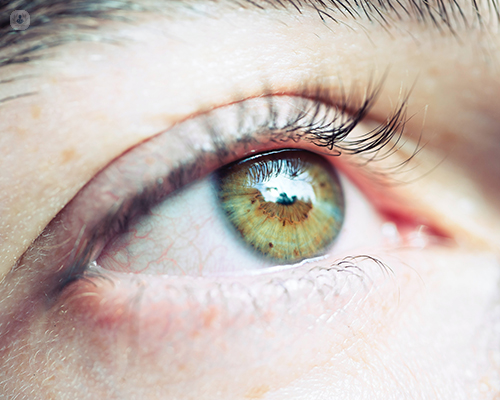Spotted: ocular naevus in our eyes
Autore:Just as on the skin, there can appear freckles or spots that look like moles on our eyes. Similarly, some may be harmless and some may require medical professional attention. In this article, renowned and esteemed consultant ophthalmologist Professor Bertil Damato explains in detail what ocular naevus is and answers important questions.

What is an ocular naevus?
Ocular naevus (i.e., ‘mole’) is a benign (i.e., non-cancerous) tumour (i.e., swelling) composed of melanocytes. These are cells that produce melanin pigment. Melanin absorbs light to protect surrounding tissues from damage caused by ultraviolet radiation.
Within the eye, most naevi develop in the choroid, a thin, cup-shaped tissue lying under the retina, at the back of the eye, and in the iris, the grey, brown, or blue tissue that adjusts the size of the pupil to regulate the amount of light reaching the retina. Naevi can also develop outside the eye, in the conjunctiva, which is a transparent membrane covering the white of the eye and the inner surface of the eyelids.
How common are ocular naevi (‘moles’)?
Choroidal naevi are found in about 6 per 100 individuals, more commonly in light-grey or blue eyes than in brown eyes. Conjunctival naevi are less common, especially in individuals with a dark complexion.
How are ocular naevi diagnosed?
Choroidal naevi are usually small and flat with a featureless, grey surface. In a small minority of patients, the lesion is larger than usual so that it is called ‘suspicious naevus’. To help optometrists and ophthalmologists distinguish benign naevi from malignant melanomas, Professor Damato has developed MOLES, an acronym which stands for mushroom shape, orange pigment, large size, enlargement, and subretinal fluid. Each of these features is given a score between 0 and 2. Tumours are diagnosed as common naevus, low-risk naevus, high-risk naevus, and probable melanoma according to whether the sum total of these five scores is 0, 1, 2 or more than 2. The recommended management is for patients with common naevi to be monitored by a community optometrist, with patients having a low-risk or high-risk naevus referred to an eye specialist for expert examination, with those having a probable melanoma referred urgently, to be seen by an eye specialist within two weeks.
Conjunctival naevi tend to be small, usually containing several visible clear cysts. The tumour colour varies from black to light grey or brown.
What problems can naevi cause?
Very rarely, choroidal naevi show malignant (cancerous) growth, when they are termed ‘melanoma’. All naevi should therefore be documented, by photography if possible, and reviewed every two years, or more frequently if any suspicious features are present (i.e., MOLES score >0, see above). Conjunctival naevi can also show malignant growth, albeit rarely. Some patients consider their conjunctival naevus to be a cosmetic problem.
How are ocular naevi treated?
Choroidal naevi are not usually treated unless the risk of malignancy is high, in which case they are managed in the same way as small melanomas. In some cases, it is possible to establish the diagnosis by biopsy.
Conjunctival naevi can be removed if there are concerns about malignancy or if they cause cosmetic deficit. Surgical excision is performed under local anaesthesia, with sedation.
If you have recently noticed a spot on your eye or someone's you know, you can get it checked and schedule a consultation at Professor Damato's profile.



